Side Yard Landscaping Ideas
Five design ideas for long, narrow side yards
By Maureen Gilmer, landscape designer, author and LandscapingNetwork.com columnist
-
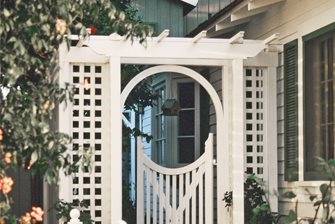 This tiny beach house has a side yard visible from the street, but this classic lattice gateway provides enough screening to reclaim that space.
This tiny beach house has a side yard visible from the street, but this classic lattice gateway provides enough screening to reclaim that space.
-
 A tiny Asian inspired space offers seating for one and a beautiful Clematis jackmanii on the fence.
A tiny Asian inspired space offers seating for one and a beautiful Clematis jackmanii on the fence.
-
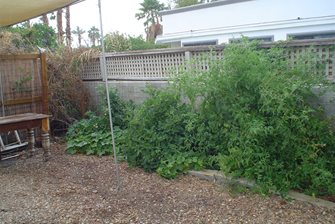 Grow food in sideyards wide enough to provide enough sun for flowering vegetables.
Grow food in sideyards wide enough to provide enough sun for flowering vegetables.
-
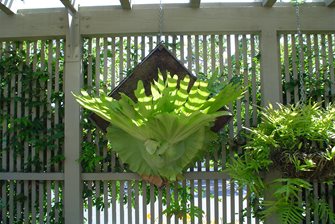 Using an arbor or lath structure to increase side yard privacy allows you to use an eye-popping focal point viewed every day through door or window.
Using an arbor or lath structure to increase side yard privacy allows you to use an eye-popping focal point viewed every day through door or window.
-
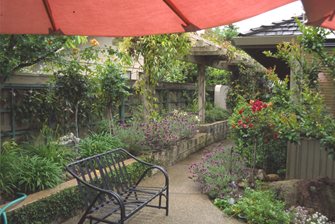 This side yard features a privacy arbor, raised planting beds and a narrow fountain in front of the sliding door.
This side yard features a privacy arbor, raised planting beds and a narrow fountain in front of the sliding door.
-
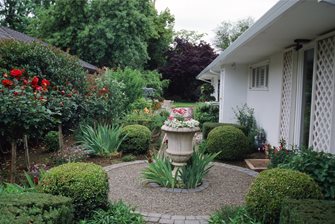 This large lot side yard offers a convenient pea gravel walkway with the focal point in front of the master bedroom French doors.
This large lot side yard offers a convenient pea gravel walkway with the focal point in front of the master bedroom French doors.
-
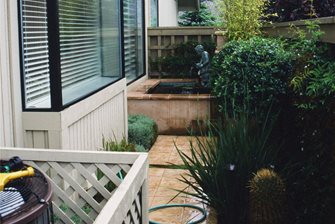 This narrow side yard shows how to disguise the air conditioner, and further down the fountain offers a view from the formal dining room.
This narrow side yard shows how to disguise the air conditioner, and further down the fountain offers a view from the formal dining room.
-
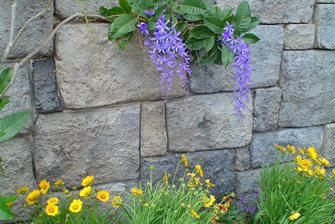 Well behaved vines with beautiful flowers are highly desirable side yard planting.
Well behaved vines with beautiful flowers are highly desirable side yard planting.
-
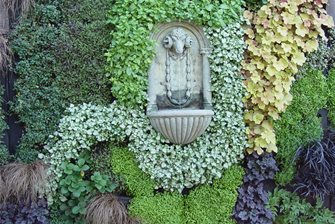 New technology allows you to plant vertically around a wall fountain for an outstanding side yard view without sacrificing any floor space.
New technology allows you to plant vertically around a wall fountain for an outstanding side yard view without sacrificing any floor space.
-
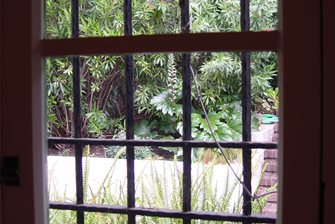 Too often builders ignore the view from side yard windows but a good landscape designer can change that.
Too often builders ignore the view from side yard windows but a good landscape designer can change that.
- 1
- 2
- 3
- 4
- 5
- 6
- 7
- 8
- 9
- 10
Side yards are more than just a link from front yard to back. For smaller lots, this narrow strip is vital outdoor space that must be included in the overall design. Large lot side yards are a great opportunity to add diversity to the landscape. If you're spatially challenged, insist your designer consider these five potential opportunities for utilizing these long, narrow spaces.
Side Yard Tips & IdeasGet more ideas for side yard landscaping including:
- Possible uses for a side yard
- Tips from landscaping experts
- Selecting plants for side yards
- Plus more...
View more side yard design ideas or check out this side yard transformation with stock tanks.
Window ViewsExcept for those rooms in the front and back of your house, the rest of the windows open onto a side yard view. This features the perimeter fence or wall and the neighbor's house and windows, which is why most people keep their shades drawn. But if you design your side yards properly you'll open the drapes to a beautiful tableau and let the sun shine in every day.
While you can't raise the fence due to building codes, you can stand a taller panel against it to increase height for each individual window. This panel might be lattice, woven bamboo, ironwork or best of all, new vertical wall planting units. Onto this panel you can hang a wall fountain or art work. Plant vines so panels double as a trellis to surround the focal point with foliage and flowers. In narrow side yards, opening the window brings the soothing sound of water indoors to cool the day or as white noise to cloak city din at night.
- Pro Tip: A typical panel will measure 4' by 8', so you may need two of them to fit a wide window or a sliding glass door
Door AccessSome homes feature rooms that open onto side yards, usually with a sliding glass door. This makes this threshold a vital link to the overall circulation of the landscape. Too often builders play down these access points but a good designer knows other ways to transform them into real amenities.
Borrowing space is a very old design technique that allows you to visually extend the interior colors and style of the room into the adjacent outdoor space. Select pavers or just simple stepping stones that resemble the flooring in the room for that part of the side yard walkway. Add plants that suit the interior decor style such as potted bamboo for Asian, ferns for English and bougainvillea for Spanish. Accessorize this outdoor space with similar artistic elements to further this look and feel. Such compositions allow you to literally borrow space outdoors to augment a too-small bedroom or give a home office a view. When the door is closed it's beautiful to look at, but when open the sights and smells of a planted garden bring you closer to nature.
Tiny Living SpacesSide yards vary in width from four feet to twenty feet or more depending on the homesite. Where there is at least six to ten feet in side yard width, there's enough room to create a tiny oasis. This space may support just a single lounge chair or a chaise, which makes an ideal for a single-person getaway.
The key to making this space pleasant is to ensure privacy and surround it with beautiful plants. The choices should offer you beauty at close range, so choose more exquisitely detailed flowers and leaves. If the side yard is already paved, plant in highly attractive pots. Secondly, give yourself some privacy so you can go out and relax in your robe without the neighbor kids ogling you from second story windows. An excellent way to solve this problem is to consider an arbor structure. This provides the framework for a seasonal cover to cut the view from above, or you can hang roll up shades to screen off the sides during the milder seasons. These can be raised and lowered as sun and nosy neighbors require.
- Pro Tip: Homeowners associations and city building codes can be picky about structures in side yards. To avoid conflicts, discuss your plans with the neighbor first because an unhappy homeowner is the fastest way to bring it to the attention of code enforcement.
Vertical PlantingThe primary problem with side yards is lack of ground space. You must, above all, maintain a clear pathway from one end to the other because this is its primary function. This limits square footage for plants and dictates their shape and habit. Vines present some of the best options because one stem can support a massive amount of foliage and flowers. This can engulf your ugly fence or be trained to frame views and artistic elements. Above all, these vines should not be the rampant types such as honeysuckle or wisteria, but smaller choices such as clematis which require less pruning to maintain a limited size.
5 Vines for Side Yard Color and Fragrance
| Bignonia violaceae | Scarlet Trumpet Vine |
| Bougainvillea 'Purple Queen' | Purple Queen Bougainvillea |
| Clematis armandii | Evergreen Clematis |
| Gelsemium sempervirens | Carolina Jessamine |
| Jasminum polyanthum | Jasmine |
Sunlight is limited in narrow side yards because adjacent buildings can block direct exposure. Sun will reach more of the space with every additional foot of width, particularly if the buildings are single story. North facing side yards can be shaded all year round. Therefore these are havens for small shade loving plants that offer beautiful foliage and sometimes even flowers. Such protected areas are perfectly adapted to hostas and ferns along with plants from the forest floor such as columbine and primroses.
- Pro Tip: Buy the tallest vines you can find so that the tips of the runners are already high on the fence where there is adequate sunlight. Small vines will languish in the shade.
Food GardensDepending on the size and exposure of your side yard, it can become a useful source of organic produce. Limited light typical of these slots between buildings won't support flowering veggies, but they be good for all kinds of salad and pot greens such as kale, lettuce or arugula. The same applies for some root crops such as radishes and carrots. In warm climates where greens bolt into flower prematurely or become bitter due to dry air, high temperatures or extreme UV, a side yard becomes the problem solving location for these crops.
Creating narrow planting strips or raised beds in the side yard is a fine sustainable idea for new homes. If you're lucky enough to have a south facing exposure, you may be able to grow other food plants too. Plan for piping automatic sprinklers or a drip system so this garden thrives with little attention. When beds are set against the house rather than the fence, the plants are not visible from side yard windows, which means you don't have t look at the end of the season frost-killed plants.
|
Maureen "Mo" Gilmer is a landscape designer, author, and speaker about horticulture topics and landscape design. |




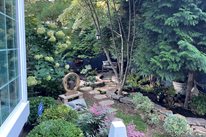 Side Yard Retreat
Side Yard Retreat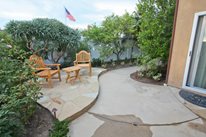 Small Yard Landscaping
Small Yard Landscaping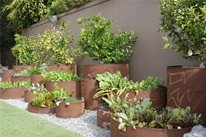 Vegetable Garden Design
Vegetable Garden Design

